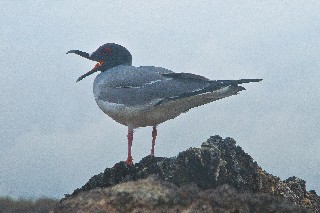The Galápagos in Panama: Swallow-tailed Gull Expanding their range

There is an annoyance among many in the field of Ornithology, which I am not above when writing about gulls. There is no such thing as a “seagull” there are only gulls. There are many types of gulls, many species around the world, but never in contemporary Ornithological literature will you find the term “seagull”. So now that we have that clear, lets talk about one gull in particular, the swallow-tailed gull, mostly known as the world´s only nocturnal gull and even more popularly by its primary residence, the Galapagos Islands. The swallow-tailed gull (SWTAGU) or Creagrus furcatus was first described as late as the 1840´s by Adolphe-Simon Neboux.. The SWTAGU is named aptly whereas Creagrus or Creagra translates to “butcher” or more accurately “flesh-hook” and furca translates to “fork” referring to the birds forked tail. While mainly nesting on the Galapagos Islands this bird does have another confirmed breeding site on Malpelo Island off the coast of Colombia. This bird as a habit, post-breeding, of becoming highly pelagic (sea-going) and can often be found over 500km from its home range.
How does this have anything to do with Panama? Interesting and consecutive observations have led to an upcoming project of inquiry by the organization, Conservación Panamá. The SWTAGU was observed on 6 occasions in 2012, 5 occasions in 2013 and 3 occasions in 2014 in the Bay of Panama! This is exciting and very interesting news in the annals of Ornithology as this bird has rarely been observed in Panamanian waters in the past.
Of what significance is this? This leads us to hypothesize that this species has either expanded its range or even more likely has made parts of the Bay of Panama a regularly visited site during the non-breeding pelagic phase of adults and juveniles alike. What has caused this change? Is this a change? Is our current knowledge of this species range erroneous? If this is a range expansion, what has caused it? Could the SWTAGU be considered a “bio-indicator” species? What has changed in the environment to cause such a change in range? Is it possible this species has new breeding colonies closer to Panamanian waters? These are a few of many questions that have revealed themselves in light of our observations.
Conservación Panamá has a project for 2015, which is in the design and development phase, that will hopeful answer a few of these questions. We will survey a variety of areas throughout the Bay of Panama to help ascertain if this species is truly being seen on a regular basis in Panamanian waters or if our observations were transitory vagrant individuals.
Answering even a few of these questions could have an enormous significance towards the conservation and management of this species. Imagine if the SWATGU has truly expanded its breeding territory or has expanded its non-breeding pelagic range? This could change our understanding of this species completely.
If you or someone you know has access to a sailing vessel or motorized vessel that has multi-day capabilities, radar and navigations aids, please contact our organization. We are aggressively searching for a vessel owner who that might be able to donate time and resources to our initial surveys in 2015. Contact: ezekieljakub@conservacionpanamaca.org
Source for gull information: BirdLife International (2014) Species factsheet: Creagrus furcatus.
Conservación Panamá is a Panamanian - U.S. NGO working to assist in conservation and management of natural resources. Ezekiel S. Jakub is the Executive Director of Conservación Panama. His current area of research is bird conservation.
